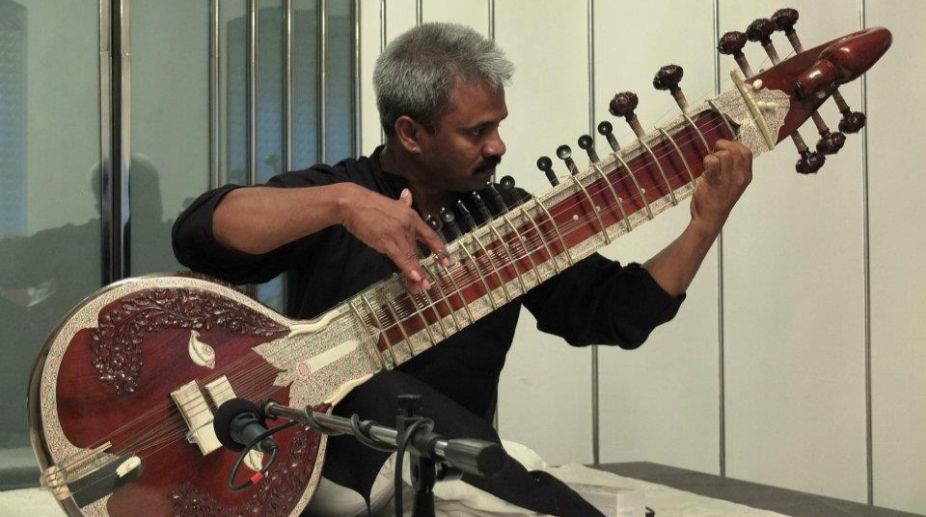Shriram Shankarlal Music Festival held in Delhi
The Music Festival was held from March 27-29 at Shriram Bharatiya Kala Kendra Lawns, Copernicus Marg, New Delhi.

Rajeev Janardan (Photo: FacebooK
As is their annual ritual, the disciples of Pandit Arvind Parikh organised a musical congregation on the auspicious occasion of Guru Purnima at Rangeshwar Hall, YB Chavan Centre, Nariman Point, Mumbai.
This year there was another special reason for the celebration, as their world-renowned Guru has been awarded the prestigious Sangeet Natak Akademi Ratna Sadasyata (Fellowship) for his vast knowledge and passion-driven selfless service to classical music.
It was led by Dr Suvarnalata Rao (a scientist-musician who heads programming, Indian Music, NCPA), Deepak Raja (eminent musicologist-musician and author), renowned columnist-musician and composer Tushar Bhatia, most of whom are straddling parallel careers following in the footsteps of their revered Guru.
Advertisement
On behalf of the entire Parikh Parivar in her welcome address, Rao offered gratitude to their Guru who, apart from heading a successful business empire, has been transmitting the tradition of his ustad, Vilayat Khan.
Both, eminent vocalist Pandit Ulhas Kashalkar, who inaugurated the event, and sitar maestro Shahid Parvez, who was present, reiterated that Vilayatkhani Baaj lives on through the untiring efforts of Arvind bhai, a fountainhead of knowledge and wisdom.
In the presence of several other distinguished musicians including Pandit Dhruba Ghosh (who unfortunately left for his heavenly abode the next day) this year’s event was spread over two full days featuring recitals of 35 disciples of Arvind bhai, many of whom play sitar, surbahar, shehnai, violin and even sing.
Performers
There were many who have evidently carved a niche for themselves as seasoned musicians and among them two Kolkatans stood out. As the final artist of the entire event, sitar virtuoso Ramprapanna Bhattacharya gave a recital of raga Shuddh Kalyal and followed it up with a dhun.
The well-edited blend of amazing taiyari, impressive raagdari and soulful melody, within a short time-frame, was stunning. Young shehnai player Hassan Haidar Khan, son-disciple of Ustad Ali Ahmed Hussain Khan, is being exposed to the richness of melodic content by Arvind bhai and it showed in his reposeful, beautiful delineation of Bilaskhani Todi,the opening raga of the entire event.
Ashwin Dalvi, the sole surbahar virtuoso played an elaborate alap in raga Alhaiya Bilawal with a unique difference. It included delightful khayal inflections instead of the usual dhrupadbased elaboration.
The raga elaboration with dexterous melodic movements using both gentle and bold tones, as displayed by sitarists Rajeev Janardan (Gunjikauns), Mahboob Nadeem (Yaman) and Rafat Khan Niyazi (Puriya) were very impressive. While the traditional Puriya is this gharana’s forte and the oceanic evening melody Yaman is an all-time great; Gunjikauns, invented by Arvind bhai, blending Malkauns and Malgunji demanded special care and sensitive handling.
Janardan did this beautifully by extracting the maximum emotions out of the komal swaras that were juxtaposed byshuddha swaras in the tapestry of this beautiful raga.
Brilliance
There were others who impressed with their brilliance. Little master Danish Khan (raga Yaman) proved that he has his focus fixed. The grit and passion of Madhura Karambelkar (Bhinna Shadaj in Rageshri anga)showed in abundance. Bhupal Panshikar (Shuddh Sarang), Nishad Mistry (Alhaiya Bilawal) and Sarang Bhosale (Yaman) etched crystal clear raagroop, and with touching sensitivity.
However, Sunder Nath (Bhairav) who has mastered the technique could do better by striking a better understanding with the raga he chose. An inconsistent Maruti Patil (Kalavati) was impressive in patches; so was Pulak Lahiri (Shuddh Sarang). Tushar Bhatia (Kafi) offered a beautiful self-composed gat-bandishas his gurudakshina.
Pure taaleem
Most of the others displayed honest adherence to taaleem, which, in time, leads to innovations, the backbone of Hindustani classical music.
Raga Desh on Rudraveena was played in khayal anga by Sharada Mushti. Pilu was the choice of Varad Bhosale and Altaf Khan and both adhered to almost the same path of delineation. Sitarists Jnanesh Amladi (Marwa), Amruta Kulkarni (raga Madhukauns), Nishita Tambe (Jhinjhoti), Gunkali Bhosale (Gurjari Todi) and vocalist Harpreet Singh Hassrat (Patadeep) displayed promise.
Devotion was the keynote of violinist Subhasha Mishra’s Bhimpalasi. It was this devotion towards music that brought many more to offer their recital at the feet of their mentor.
Support system
The melodic structure of the entire soiree rested on the shoulders of tabla exponents Anutosh Degharia (disciple of Ustad Sabir Khan) and Bhushan Parchure (disciple of Ustad Zakir Hussain) with short relief provided by Zafar, Khan, Ayub Khan, Dhawal Mistry and Prafulla Sohale.
In the present scenario when the Gurukuls are dwindling, this is perhaps the only Guru Purnima celebration under the able wings of Arvind bhaithat provides an opportunity to all his disciples to exchange melodious ideas with their brethren, to gauge progress, strengthen bonds and seek advice from their Guru for a better future.
Advertisement